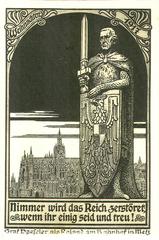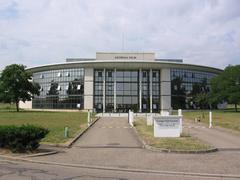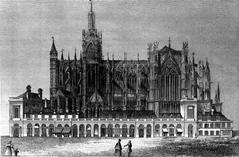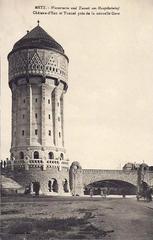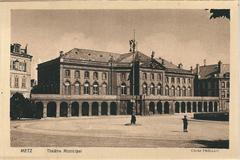Complete Guide to Visiting Église Saint-Clément de Metz: Hours, Tickets, History & Nearby Attractions
Date: 04/07/2025
Introduction: Discovering Église Saint-Clément de Metz
Situated in the historic city of Metz, France, Église Saint-Clément de Metz is a captivating emblem of religious heritage and architectural grandeur. Dedicated to Saint Clement, the city’s first bishop, the church not only reflects Metz’s deep spiritual traditions but also embodies a unique blend of Baroque and Gothic styles. Its legendary association with the tale of Saint Clement’s victory over the Graoully dragon is woven into the cultural identity of Metz, making the church a focal point for both local legend and enduring faith (Monumentum; Wikipedia: Clement of Metz).
Over centuries, Église Saint-Clément has served as an abbey church, a Jesuit college, a military facility, and now as an active parish and protected monument. Its evolving roles highlight the church’s significance in Metz’s religious, educational, and civic life (petitfute.com). With practical amenities for visitors and a prime location in the Pontiffroy district—close to Metz Cathedral and the Centre Pompidou-Metz—Église Saint-Clément is a must-visit for cultural travelers and history enthusiasts (visitsights.com).
Historical Overview
From Foundations to Legend
Église Saint-Clément de Metz’s roots are anchored in early Christian Metz. Named after Saint Clement, regarded as the city’s first bishop, the church’s origins are intertwined with both documented history and local legend. The legend of Saint Clement’s defeat of the Graoully dragon—a symbol of paganism—remains a cornerstone of Metz’s cultural fabric (Wikipedia: Clement of Metz).
Historically, the earliest authenticated bishop of Metz is Sperus (535 CE), but the church’s dedication to Saint Clement asserts a symbolic connection to the city’s foundational spiritual narrative.
Architectural Evolution: Baroque Meets Gothic
The present church was constructed between the late 17th and early 18th centuries. The project began under architect Jean Spinga and saw significant contributions from local architects Louis and Barlet. The Baroque influence is immediately evident in the church’s façade and grand staircases, while Gothic elements—such as pointed arches and vertical lines—endure in the building’s structure (france-voyage.com; frenchmoments.eu).
The church’s role shifted dramatically during the French Revolution, when its interior was gutted and the building was repurposed for military use (Monumentum). In the 19th century, the Jesuits transformed the site into a college, restoring much of its ecclesiastical grandeur and adapting it for educational purposes.
Modern Restoration and Preservation
Classified as a Monument Historique in 1972, Église Saint-Clément has benefited from ongoing preservation efforts, including roof repairs and interior restorations. Today, the former abbey complex houses administrative offices, demonstrating adaptive reuse while safeguarding the site’s heritage (france-voyage.com).
Architectural Highlights
A Synthesis of Styles
Église Saint-Clément de Metz is renowned for its synthesis of Baroque exuberance and Gothic solemnity. The Baroque façade, with its dynamic forms and ornamentation, contrasts harmoniously with the verticality and spatial logic of its Gothic-influenced nave (visitsights.com).
Key Features
- Cloister: The abbey’s cloister, influenced by Italian Baroque, is adorned with sculptures representing the Four Cardinal Virtues, offering a quiet space for reflection (france-voyage.com).
- Chapelle Notre-Dame-du-Perpétuel Secours: A 19th-century addition displaying neo-Baroque and neo-Romanesque styles, complementing the older church structures.
- Structural Layout: Designed as a hall church, the nave and aisles are of similar height, creating an open, communal worship space.
- Decorative Elements: Ornate stucco work, gilded altarpieces, finely crafted stained glass, and a historic pipe organ mark the interior’s artistic richness.
Religious and Cultural Significance
Saint Clement and the Graoully
Saint Clement’s legendary defeat of the Graoully dragon is a symbol of Christianity’s triumph over paganism and remains central to the church’s identity. The church hosts annual celebrations in his honor, reinforcing its role as a spiritual anchor for Metz (metz.fr).
Community and Educational Heritage
Transformed into a Jesuit college in the 19th century, Église Saint-Clément became a hub for education and spiritual formation. Today, it continues to serve as an active parish, hosting religious services, cultural events, and community gatherings.
Musical and Artistic Legacy
The church’s acoustics and historic organ make it a favored venue for concerts, especially during festivals. Artistic treasures such as the master altar, the painting “Déploration du Christ,” and vibrant stained glass windows further enrich its cultural offering (Monumentum).
Visiting Information
Location and Access
- Address: Place Gabriel Hocquard, Pontiffroy district, 57000 Metz, France
- Public Transport: Multiple bus lines serve the area, with stops nearby.
- Parking: Public parking is available, though public transport is recommended during peak periods.
Opening Hours
- General Visiting:
- Monday to Saturday: 9:00 AM – 12:00 PM & 2:00 PM – 6:00 PM
- Sunday: 10:00 AM – 6:00 PM
- Note: Hours may vary on holidays or for special events (horairedemesse.fr).
- Mass Times:
- Monday and Friday evenings
- Tuesday mornings
- Saturday evenings
- Sunday mornings
Admission & Tickets
- Entry: Free
- Guided Tours: Available via local tourist offices; some special exhibitions or tours may require a ticket.
Accessibility
- Mobility: Ramps at the main entrance; some areas may have limited access due to historic features.
- Hearing: Magnetic loop system installed for the hearing impaired.
Visitor Tips
- Dress Code: Modest attire recommended.
- Photography: Permitted without flash; restrictions may apply during services.
- Best Times: Early mornings or late afternoons for a quieter experience.
Nearby Attractions
- Metz Cathedral (Cathédrale Saint-Étienne): Known for Gothic architecture and remarkable stained glass.
- Centre Pompidou-Metz: Leading contemporary art museum.
- Place Saint-Louis, Basilica of Saint-Vincent, and Consistorial Synagogue: All within walking distance for a comprehensive historical tour.
Frequently Asked Questions (FAQ)
Is there an admission fee?
No, entry is free. Donations are appreciated.
When is the church open for visits?
Typically Monday–Saturday, 9:00 AM–12:00 PM and 2:00 PM–6:00 PM; Sunday, 10:00 AM–6:00 PM. Confirm before your visit, as times may vary.
Are guided tours available?
Yes, through local tourist offices or by appointment.
Is the church accessible for those with disabilities?
Main areas are accessible; some historic features may limit access in certain sections.
Can I take photographs?
Yes, but avoid flash and respect any signage or staff instructions.
Visuals and Planning Resources
For the best experience, view high-quality images of the church’s façade, cloister, interior, and stained glass. Incorporate map visuals showing the church’s proximity to other attractions. Download the Audiala app for guided tours and event updates.
Conclusion: Why Visit Église Saint-Clément de Metz?
Église Saint-Clément de Metz is much more than a historical monument; it is a dynamic site where faith, legend, art, and community converge. Its rare architectural synthesis, storied past, and active role in Metz’s religious and cultural life make it an essential stop for any visitor. Whether you’re drawn by its legend, its art, or its vibrant parish life, a visit to Église Saint-Clément promises a meaningful encounter with Metz’s enduring heritage.
For the latest visitor information, events, and travel tips, consult the official resources and consider using the Audiala app for a curated experience.
References & Further Reading
- Monumentum
- france-voyage.com
- metz.fr
- sainte-eglise.com
- Wikipedia: Clement of Metz
- petitfute.com
- visitsights.com
- frenchmoments.eu

